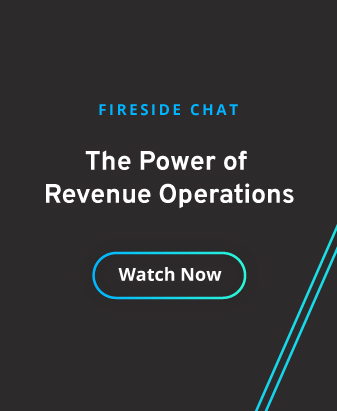On Demand Fireside Chat: What is Revenue Operations?
Revenue operations has been on the rise for the last few years. In a SiriusDecisions study, there was an 81% increase in title changes on Linked that included “revenue”. The same study shared that 46% of companies had revenue operations as an established function, reporting to a Chief Revenue Officer.
The revenue operations or a.k.a “rev ops” function, is increasingly a hot topic in the B2B space, but with it only coming into relevance within the last few years, there is debate about what it actually means and what it does for an organization.
To get the expert insight, I interviewed the Founder & CEO of SaaScend, Craig Jordan, on a fireside chat.
Revenue Operations Fireside Chat Main Takeaways
❶ What is revenue operations?
Revenue Operations aligns the three different operational teams within the go-to-market function, sales, marketing, and customer success, into one uniform structure.
❷ What does revenue operations do within an organization?
The purpose of the rev ops role is to align sales, marketing, and customer success focusing on their processes, integrations, and reporting, encompassing how a lead or prospect progresses through the funnel across the three teams. Addressing any operational points of inefficiency that need to be fixed, augmented, or adopted, especially as the company goes through different evolutionary stages.

❸ What are some challenges that revenue operations can help solve?
Have you ever heard of the idea of leads falling through the cracks? It is because it can happen often when there is not a defined and streamlined process when marketing passes a lead over to sales. Transitions like this happen all throughout the funnel.
Revenue operations helps to define and build transition process support systems, so that leads can transition through the funnel faster and more efficiently, producing a better overall buyer experience, and not have leads fall through the cracks. Examples of these processes can include lead qualification, lead routing, funnel mapping, lifecycle stages, and the technical integrations that automating these solutions require.
❹ When is it time to bring in a revenue operations function into the organization?
First, have product market fit, then once a small sales team is established with a semi-leader that might be spread between two roles, such as the Founder & CEO and Head of Sales, or the Head of Sales and Sales Ops, consider focusing on your rev ops in the early stages. The main takeaway here is to at least have it defined and in place before starting to scale up.
❺ Why is revenue operations important?
The whole purpose of operations is to create efficiencies, compound, and act as a force multiplier. As rev ops has visibility into the processes of sales, marketing, and customer success, they will be able to discover areas that can be streamlined or automated to save your team time. For example, if one sales representative generates $1M a year, with revenue operations they could be generating $14M because they would be able to operate more efficiently, having more calls with the right leads, and generating more pipeline.

Craig Jordan, CEO & Founder, SaaScend
If you don’t prioritize operations and put in place some of these basic functions, you’re literally leaving money on the table.
❻ What are the metrics that revenue operations focuses on?
Number one is revenue. The other metrics pertain to the transition points in the funnel. For example, the Marketing Qualified Lead acceptance rate and the time between when a deal is marked as closed won and the kick-off call with a customer. Analyzing these metrics will provide insight into if you have a leaky funnel, and pinpoint where the inefficiencies are.
It is critical for rev ops to understand the rate of conversion, the predictability of revenue, and the progression of revenue. They need to be asking themselves, are we doing the best we can to progress people through the funnel as fast as possible? Understand your baseline of performance first, so that when changes are made to processes with the goal of making them more efficient, the delta can be measured between the two, producing the rate of improvement.
❷ What does revenue operations do within an organization?
The purpose of the rev ops role is to align sales, marketing, and customer success focusing on their processes, integrations, and reporting, encompassing how a lead or prospect progresses through the funnel across the three teams. Addressing any operational points of inefficiency that need to be fixed, augmented, or adopted, especially as the company goes through different evolutionary stages.

Revenue Operations Biggest Mistakes to Avoid
Companies often acquire new technology with the thought that it is the solution to their problems. – Without a plan in place, new software will only add to your business’ technical debt. Develop the strategy first and ask yourself, how are you going to leverage the tool in the shorterm, the medium-term, and the long term, how are you going to benchmark the tool to measure whether it is actually effective, and who is going to own it?
Thinking that revenue operations is a cost center. – It is one of the most powerful and impactful functions that can help a company scale by empowering their GTM teams to operate more efficiently, saving time and resources, to drive more revenue for the business.
Fireside Chat in a Nutshell
Revenue operations aligns sales, marketing, and customer success, concentrating on their processes, integrations, and reporting to empower them to operate with efficiency, saving them time and resources, so that they can focus on their customers and growing the business.
Access the fireside chat on demand to listen to the full conversation.



